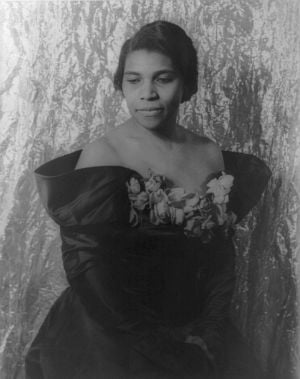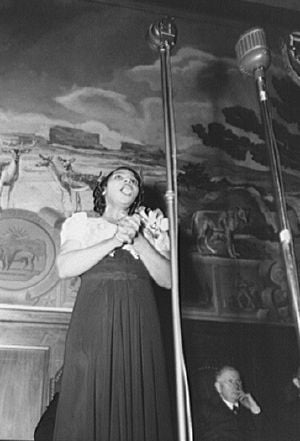Marian Anderson
Marian Anderson (February 17, 1898 – April 8],1993) was an African American contralto (same range as alto), best remembered for her performance on Easter Sunday, 1939 on the steps of the Lincoln Memorial in Washington D.C..
Childhood and Education
Marian was thought to be born in Philadelphia, PA on Feb. 17, 1902 (although her death certificate records her birthdate as Feb. 27, 1897) to her father, a coal salesman, and her mother, a former teacher. She early showed giftedness in music beginning with the violin and switching to voice. The black community provided financial help to train her as she came under the tutelage of tenor Roland Hayes. She first experienced racism when applying for entrance to music school. She walked away and was later able to obtain free lessons from a teacher. She studied further with tenor/coach Giuseppe Boghetti, and gained confidence and knowledge as he guided her with public performances. [1]
"I don't think I said a word. I just looked at this girl and was shocked that such words could come from one so young. If she had been old and sour-faced I might not have been startled. I cannot say why her youth shocked me as much as her words. On second thought, I could not conceive of a person surrounded as she was with the joy that is music without having some sense of its beauty and understanding rub off on her. I did not argue with her or ask to see her superior. It was as if a cold, horrifying hand had been laid on me. I turned and walked out." 2
She did, however, find a teacher who gave her lessons for free. Later, with donations from a local church, Anderson studied with tenor/coach Giuseppe Boghetti. She toured regionally, gaining knowledge and confidence with each performance. In 1924, she gave her first recital at New York's Town Hall. The concert revealed Anderson's discomfort with foreign languages and almost caused her to end her vocal career. [2]
FAMILY BACKGROUND: Marian Anderson was the oldest of three daughters born to John and Anna Anderson. John was a loader at the Reading Terminal Market, while Anna had been a teacher in Virginia. In 1912, John suffered a head wound at work and died soon after. Anna and her three daughters moved in with John’s parents, while Anna found work cleaning, laundering and scrubbing floors.
EDUCATION: Marian attended William Penn High School (focusing on a commercial education course to get a job) until her music vocation arose. She transferred to South Philadelphia High School, focusing on music and singing frequently at assemblies, and graduating at age 18. She applied for admission to a local music school, but was coldly rejected because of her color.
ACCOMPLISHMENTS: Marian’s musical career began quite early, at the local Baptist church in which her father was very active. She joined the junior choir at age six. Before long, she was nicknamed “The Baby Contralto.” When she was eight, her father bought a piano from his brother, but they could not afford any lessons so Marian taught herself.
When Marian was 13 years old, she joined the senior choir at church and began visiting other churches; becoming well-known and accepting invitations to sing. She became so popular, she would sometimes perform at three different places in a single night. Finally she summoned the confidence to request five dollars per performance. In 1919, at the age of 22, she sang at the National Baptist Convention.
When she was 15 years old, Marian began voice lessons with Mary Saunders Patterson, a prominent black soprano. Shortly thereafter, the Philadelphia Choral Society held a benefit concert, providing $500 for her to study for two years with leading contralto Agnes Reifsnyder. After she graduated from high school, her principal enabled her to meet Guiseppe Boghetti, a much sought-after teacher. When he heard Marian audition, singing “Deep River,” he was moved to tears.
Marian’s initial invitations to sing grew to actual tours, focusing on black colleges and churches in the South. William “Billy” King accompanied her and also served as her manager. Soon she was making $100 per concert. On April 23, 1924, they took a giant step and held a concert at New York’s Town Hall. Unfortunately, it was poorly attended and critics found her voice lacking. Marian was so discouraged, she contemplated abandoning her career choice.
But shortly after, she won a singing contest through the Philadelphia Philharmonic Society and then, in 1925, she entered the Lewisohn Stadium competition. She beat 300 rivals and sang in New York’s amphitheater with the Philharmonic Orchestra accompanying her. This concert was a triumph and gained her the attention of Arthur Judson, an important impresario, who put her under contract.
In 1926, Marian toured the eastern and southern states, adding songs to her repertoire. On December 30, 1928, she performed a solo recital at Carnegie Hall. A New York Times critic wrote: “A true mezzo-soprano, she encompassed both ranges with full power, expressive feeling, dynamic contrast, and utmost delicacy.” But despite this success, her engagements were stagnating; she was still performing mainly for black audiences.
Marian then obtained a scholarship through the National Association of Negro Musicians to study in Britain. On September 16, 1930, she performed at London’s Wigmore Hall. She returned to the U.S. only to return to Europe again, on a scholarship from the Julius Rosenwald Fund. She was intent on perfecting her language skills (as most operas were written in Italian and German) and learning the art of lieder singing. At a debut concert in Berlin, she attracted the attention of Rule Rasmussen and Helmer Enwall, managers who arranged a tour of Scandinavia. Enwall continued as her manager for other tours around Europe.[3]
Career
Anderson was born in Philadelphia, Pennsylvania. She joined a junior church choir at the age of six, and applied to an all-white music school after her graduation from high school in 1921, but was turned away because she was black. The woman working the admissions counter replied, "We don't take colored" when she tried to apply. Consequently, she continued her singing studies with a private teacher.
She debuted at the New York Philharmonic on August 26, 1925 and scored an immediate success, also with the critics. In 1928, she sang for the first time at Carnegie Hall. Her reputation was further advanced by her tour through Europe in the early 1930s where she did not encounter certain racial prejudices she had experienced in America. The Finnish composer Jean Sibelius dedicated his Solitude to her. Famed conductor Arturo Toscanini told her she had a voice "heard once in a hundred years". In 1935 impresario Sol Hurok took over as her manager and was with her for the rest of her performing career.
In 1939, the Daughters of the American Revolution (DAR) refused to allow Anderson to sing to an integrated audience in Constitution Hall because of her race. The District of Columbia, then under the control of the Congress and President Franklin D. Roosevelt, also banned her for the same reason from using the auditorium of a white public high school. As a result of the furor which followed, thousands of DAR members, including the President's wife, Eleanor Roosevelt, resigned.
Ironically, neither Eleanor Roosevelt nor her husband, Franklin Roosevelt, had used their influence in a similar way when the school board turned down Anderson.
Finally, at the suggestion of Walter White, the executive secretary of the NAACP, Secretary of Interior Harold L. Ickes organized an open air concert for Anderson on the steps of the Lincoln Memorial. The concert, which commenced with a dignified and stirring rendition of "America (My Country, 'Tis of Thee)," attracted an integrated crowd of 75,000 and a much larger radio audience.
In 1943, Anderson sang at the invitation of the DAR to an integrated audience at Constitution Hall as part of a benefit for the American Red Cross. By contrast, the federal government continued to bar her from using the high school auditorium in the District of Columbia.
On January 7, 1955, Anderson broke the color barrier by becoming the first African-American to perform with the New York Metropolitan Opera. On that occasion, she sang the part of Ulrica in Giuseppe Verdi's Un ballo in maschera. The occasion was bittersweet as Anderson, at age 58, was no longer in her prime vocally. In 1958 she was officially designated delegate to the United Nations, a formalization of her role as "goodwill ambassador" of the U.S. she played earlier, and in 1972 she was awarded the UN Peace Prize.
In The End
After an extensive farewell tour, she retired from singing in 1965. However, she continued to appear publicly, narrating Copland's "A Lincoln Portrait," including a performance with the Philadelphia Orchestra at Saratoga in 1976, conducted by the composer. Her achievements were recognized and honored with many prizes, including the Kennedy Center Honors in 1978 and a Grammy Award for Lifetime Achievement in 1991.
In 1993, Anderson died of natural causes at the age of 95 in Portland, Oregon at the home of her nephew, the conductor James DePreist. She is interred at Eden Cemetery in Philadelphia, Pennsylvania.
The 1939 documentary film, Marian Anderson: the Lincoln Memorial Concert was selected for preservation in the United States National Film Registry.
On January 27, 2005, a commemorative U.S. postage stamp honored Marian Anderson with her image on the 37¢ issue as part of the Black Heritage series. Anderson is also pictured on the $5,000 Series I United States Savings Bond.
Anderson is a recipient of the Silver Buffalo Award, the highest adult award given by the Boy Scouts of America.
ReferencesISBN links support NWE through referral fees
- Freedman, Russell, The Voice that Challenged a Nation: Marian Anderson and the struggle for equal rights, New York, Clarion Books, 2004, ISBN 0618159762 OCLC: 53797147
- Sims-Wood, Janet L. Marian Anderson: An Annoted Bibliography and Discography, Westport, Conn., Greenwood Press, Connecticut, 1981, ISBN 0313225591 OCLC: 6581140
- Keiler, Allan, Marian Anderson: A singer's journey, New York, Scribner, 2000, ISBN 0684807114 OCLC: 42009449
- Kaplan, Howard S., Marian Anderson, San Francisco, Pomegranate, 2007, ISBN 0764938916 OCLC: 71004516
- Anderson, Marian, My Lord, what a morning; an autobiography, New York, Viking Press, 1956, OCLC: 377387
Footnotes
External Links
- Shawcross, Nancy, M. Marian Anderson: A Life in Song University of Pennsylvania Library/Exhibitions, Retrieved January 11, 2007
- Charting the Course of Education Through Music Marian Anderson Historical Society, Retrieved January 11, 2007
- Biography of Marian Anderson The John F. Kennedy Center for the Performing Arts, Retrieved January 11, 2007
- Marian Anderson Evisum, Inc., Retrieved January 11, 2007
- Jones, Randye, Marian Anderson (1897-1993) Afrocentric Voices in Classical Music, Retrieved January 11, 2007
- Notable Women INternational - Marian Anderson, Fem Bio, Retrieved January 11, 2007
Credits
New World Encyclopedia writers and editors rewrote and completed the Wikipedia article in accordance with New World Encyclopedia standards. This article abides by terms of the Creative Commons CC-by-sa 3.0 License (CC-by-sa), which may be used and disseminated with proper attribution. Credit is due under the terms of this license that can reference both the New World Encyclopedia contributors and the selfless volunteer contributors of the Wikimedia Foundation. To cite this article click here for a list of acceptable citing formats.The history of earlier contributions by wikipedians is accessible to researchers here:
The history of this article since it was imported to New World Encyclopedia:
Note: Some restrictions may apply to use of individual images which are separately licensed.

